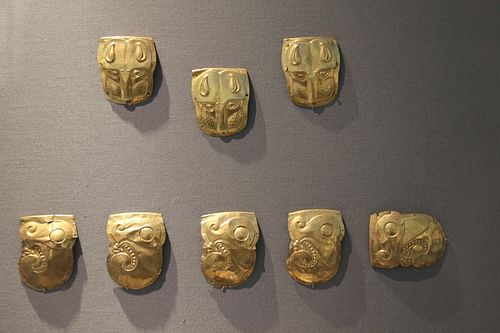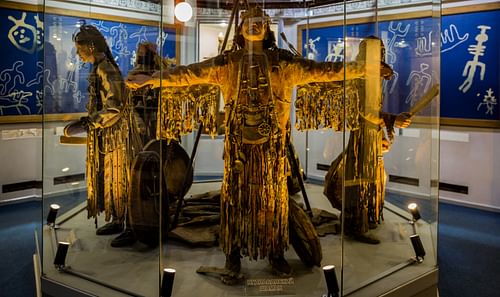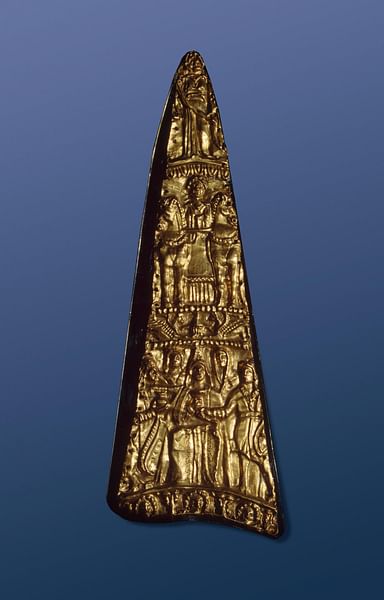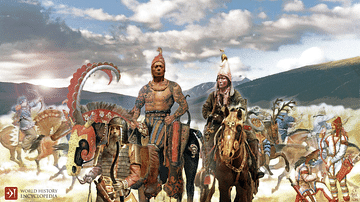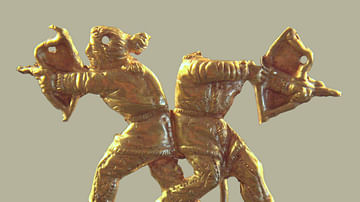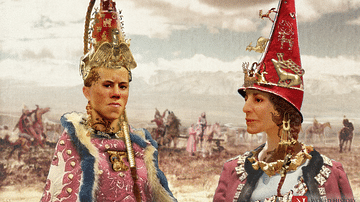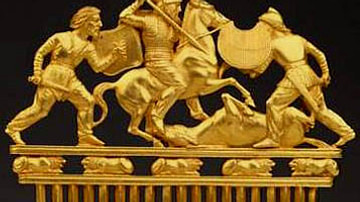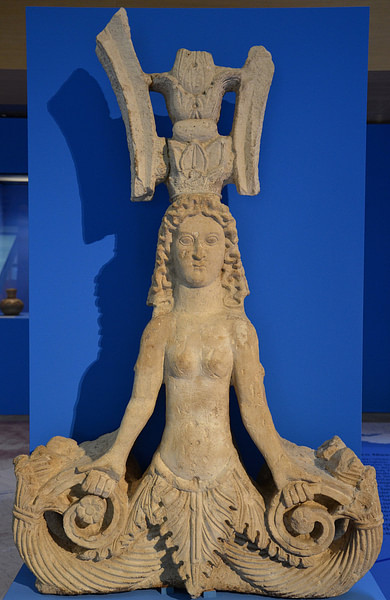
Scythian Religion appears to be an amalgam of belief in a pantheon of gods grafted to more ancient animal reverence and shamanistic practice. According to their burial finds, the Scythians appear to have had a deep affinity with the animals with which they were familiar. Perhaps residual of the primal mother-earth concept, the overwhelming number of god-images found are of a goddess.
Herodotus, however, speaks of a Scythian pantheon similar to the Greek. When he wrote in 430 BCE, Greek colonists were already established around the Black Sea, home of the Pontic Scythians. Thus, in their trade and interactions with the Greeks, the Scythians would become acquainted with their gods, and some would have familiar appeal.
Concerning social activity, though the Scythians had no temples, there is ample evidence of priestly function of their kurgans and Ares-edifices in the way of goods, construction, and associated sacrifices. Finally, when it came to individual healing, even as diviners, their shamans, through ecstatic production and medicinal prescription, certainly played important roles.
Scythian Deities
Like all ancient cultures, worship and symbolism of the elements would have been an integral part of the Scythian belief system. With the flat expanse of the steppe over which they trod, a prominent characteristic in daily life would have been the sky as it met the earth at the horizon. Another manifest feature from which the steppe offers little escape would have been the sun. Providing security against wild beasts at night and everyday practical utility in cooking and metallurgy, fire in ancient times was also essential and held considerable symbolic sway. It is not surprising then that the earth, sky, sun, and fire came to have particular theological value for the Scythians. According to Herodotus (4.127.4), in his rebut to Darius I (r. 522-486 BCE), when the Persian Achaemenid Empire invaded Scythia, the Scythian chieftain, Idanthyrsus, claimed that Hestia (goddess of fire) and Zeus (god of the sky) were the only gods to which he would bow.
Understanding the Scythian belief system from his perspective of the Greek pantheon, Herodotus relates eight deities the Scythians worshiped, though he says, except to Ares the Scythians had "no images, altars, or shrines" (4.59). Besides Hestia and Zeus, known by the Scythians as Tabitha and Papaeus, was Api (mother-earth), Goetosyrus (Apollo), and Argimpasa (Aphrodite). And though Herodotus omits their Scythian names, he also mentions Hercules, Ares, and Poseidon. Besides Hercules – the ultimate ancestor claimed by many ancient peoples – these gods represented elements with which the Scythians were familiar: Ares was associated with war, Apollo with the sun. The earth-meets-sky visual expressed itself in the belief that when the sky god, Papaeus, made union with Mother Earth, all other gods were born.
Moreover, the blessings the goddess of fertility bestowed would be essential to all cultures. While little is known about her, it is believed the Scythian equivalent to Aphrodite was Argimpasa, cognate of Arti, the Iranian goddess of material abundance. Regarding the images of a deity in the Scythian kurgans being a goddess, whether she was Api as mother earth or Argimpasa as Aphrodite, the goddess of fertility, her connection to fertility is apparent. Since it is the earth and women that give life, the mother earth concept was of primary importance to the ancients. Thus, for the same reason, a residual goddess of fertility would have a similar place of importance for the Scythians. Finally, concerning an essential element of Scythian warfare, the horse, Herodotus mentions Thagimasadas as his equivalent to Poseidon, but not as a god of the sea but as a patron of the horse.
Animal Reverence
A unique aspect of Scythian culture is the plethora and predominance of their animal images. In their kurgans, images of goddesses and daily life are found – men at war, women dancing, people at their daily tasks – but in a big way, the Scythians surrounded and covered themselves with images of animals.
One theme is that of predation. Examples include the famous Tolstaya Mogila pectoral, with bucolic scenes of daily life in the upper register, but cats and mythical griffins biting and clawing at deer and horses in the lower one. From the Bratoliubivskyi kurgan, in the Khersonska region, a gold plate shows a snow leopard attacking a stag. In the Altai Mountains at Pazyryk, leather cut-outs from saddle covers reveal cats and a griffin taking down deer. Such a common penchant for singular depictions of violent predation may reflect, for the Scythians, the violence prevalent in their own lives as warriors. Perhaps too, as they identified and imagined a parallel purpose with the images they created, they envisioned themselves, with similar ferocity, taking down their enemies.
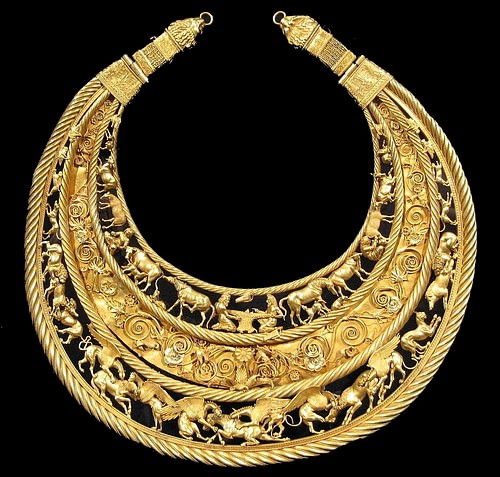
However, in other ways, it appears the Scythians interwove their destiny in more benign and beneficial ways. On the finials of priestly pole-tops are deer and birds. Found at Pazyryk are horse bridles used during times of ceremony showing images of rams, mythical eagles, and deer. Of their famous headdresses, the ones at Pazyryk and other Altai sites were typically crested with deer silhouettes and then decorated with bird figures and hairpins of silver and gold-leafed deer. At Ak-Alakha, a noblewomen's headdress was covered with feline figures of gold. Then, as we will see, at another site, bodies of the deceased elite were covered with gold panthers. Not only did the Scythians dress themselves with animals but they tattooed their bodies with them. On the body of a male principal at Pazyryk are abstract images of curled cats, stags, rams, antelope, and goats, while at another site, a female, popularly known as the Siberian Princess, also had tattoos of similar design and coverage.
While such display is known as Scythian 'animal art' and might be considered solely as fashion statements, considering the considerable admixture of religious creed to the daily life of the ancients, one has to wonder what part such images played. Since they surrounded themselves with them in such prolific ways, it appears they figured their destiny was intertwined, and as such, their animal images provided real fortune and protection.
Priestly Function
Though Herodotus does not mention priests per se, there is a plethora of archaeological evidence supporting priestly function. In the Tuva region of Russia, at the Arzhan-1 burial site, a massive conical kurgan dating to the late 9th century BCE was excavated between 1971 and 1974. Measuring 120 meters (394 ft) across and 4 meters (13 ft) high, its construction consisted of a precise segmented radiating substructure of log compartments overlaid with stone slabs. Radiating from the central 8-meter (26 ft) square burial chamber were 70 additional chambers. The final touch at Arzhan-1 would likely have been the erection of a stone stela on the mound's summit.
While Arzhan-1 was thoroughly robbed of most of its grave goods, at the smaller Arzhan-2 site (dating to the 7th century BCE) 9,300 objects were found, 5,600 of them were gold, mostly tiny animal appliqués. Amazingly, 5,000 of the gold appliqués were gold panthers worn equally by the 'king' and 'queen.' Such care and construction reflect a considerable investment of time and labor by a community who, by outward appearances, loved and honored their leaders as they sought their happiness in the afterlife. As such, the kurgans were not just tombs but religious affairs.
As the purpose of a priest was to intercede for the community with a deity, the kurgans themselves suggest priestly blessings. Additionally, since sacrifices were part of the process, if ancient custom was the norm, kurgan construction, arrangements, and sacrifices would not only have been blessed but also ritually orchestrated. At Arzhan-1, within the central grave area, were eight of the chief's attendants. In the surrounding chambers were groups of horses, some with their trainers. At Arzhan-2, as the mound is surrounded by 200 burnt offering pits; evidence of human and horse sacrifice is ample.
Herodotus similarly describes one Scythian burial where "the king's concubine, his cupbearer, his cook, his groom, his squire, and his messenger" were sacrificed and buried with him; 50 horses with their warrior-riders were also sacrificed and preserved; stood up on stakes and placed around the "great barrow" they were made ready to ride at the instant of their magical resurrection (4.71-72.). Supporting Herodotus' account, a Russian/German expedition at Chertomlyk found the remains of horses and human bones scattered around the mound. Finally, considering the kurgans as religious affairs with ritual processes, Herodotus mentions a similar Scythian ritual involving their worship of Ares. Including the sacrifice of sheep, goats, and horses, they built square two-tiered stepped structures of sticks. Finalizing the process, like the stelae at the summit of their kurgans, they placed a single sword at the top.
While the ritual process involving these Ares-edifices and the kurgans is not in doubt, who performed the rites is still a question. Were they a priestly class or diviner class, like the shamans? Traditionally, while ancient priests directed and blessed communal activity through ritual sacrifice, the shaman's primary role was one of a healer. Though their talent of divination was an attribute given by the gods, shamans could fall out of favor with the elite. According to Herodotus, if a shaman's revelation was found to be false, they could be burned by the king. Bound, then put in a kindle-filled wagon that was set on fire and its oxen stampeded, this dramatic scene of conflagration – with wagon yokes sometimes burning in two and oxen consumed – would have been a poignant reminder to diviners and audience alike who was in charge.
Contrariwise, in most societies, where the priestly class was well defined, the relationship between the ruling elite and priests was usually cooperative. Sometimes kings could be priests conducting rituals or they might initiate the ritual. Some, like the ancient Hawaiian kings, co-officiated with the high priest and even owned the temple. Or, as with the Romans, they might be drawn from the ruling class. However, with the Scythians, though there is ample evidence of priestly rituals, who performed them is ultimately still a guess. What is more certain is the tasks and responsibilities of their diviner class, the shamans.
Scythian Shamans
As with all ancient peoples, help from the spirit world was an expected part of everyday activity. When it came to individual healing, the shaman's function was to intercede between the individual needing help and the spirit world they wanted to importune. To prove his credentials, the shaman had to show evidence of his influence, which was achieved in two ways: ecstatic song and dance meant to impress and convince that his connections to the spirit world were real, combined with medicinal prescription that had a sufficient rate of success. This cinched for the shaman his credibility as a healer.
While the modern study of shamanism started with a focus on Siberian tribes in southern Russia (areas that were once Scythia's backyard), common features to shamanic rituals have been practiced throughout the world. In convincing their audience, they should be the go-to people in times of need; ecstatic performance has, for the shaman, always been essential. Wearing exaggerated dress and headdress (to resemble a bird, stag, or bear) and establishing ritual space around an altar, the shaman's first task was to battle evil spirits. Then, with the aid of helping spirits (usually animal or ancestral) the invocation of celestial ones could begin. Since it was believed sickness is a spiritual malady – a consequence of the soul leaving the body – the soul must therefore be restored. In Siberia, this often involved the superhuman feat of magical flight only the shaman could achieve through ecstatic trance. Risking losing his own soul on a hazardous journey to the underworld, or to celestial spheres, the shaman brought back and restored the patient's soul. Such a restorative process was essential to the shaman's healing abilities.
The shaman performed a ritual of rhythmic songs, dance, and feverous incantations, using symbolic objects like branches or feathers as props to enhance focus. Bells accentuated the shaman's animated gestures, while fire, smoke, and incense could also be used to heighten the senses, and in some parts of the world, hallucinogens would have been ingested by the shaman and audience alike. Ultimately though, while varying combinations of these elements have been used, the drum was the most universal and effective device. Mircea Eliade explains:
[The drum] has a role of first importance in shamanic ceremonies. Its symbolism is complete, its magical functions many and various. It is indispensable in conducting the shamanic séance, whether it enables him to fly through the air or to summon the spirits . . . the drumming enables the shaman to contact the spiritual world through which he is preparing to travel. (168)
Comparing objects discovered at two major burial sites and some in the Minusinsk Valley to two petroglyphs of the Tagar period can perhaps shed light on Scythian shamanism. At Ak-Alakha and Pazyryk in the Altai Tuva region elaborate stylized headdresses were found. Other items include rattles and drums. In the Minusinsk Valley (and throughout all Scythia), pole-tops with bronze rattles and bells were found. Such objects are depicted on the Tagar-period petroglyph from Georgievskaya, which shows a shaman with an exaggerated headdress, holding a rattle (or drumstick) in one hand, and a hand-drum with bells attached in the other. Then, the petroglyph from the Minusinsk Valley appears to show a shaman having achieved ecstasy, standing behind an altar in a circle of delineated space.
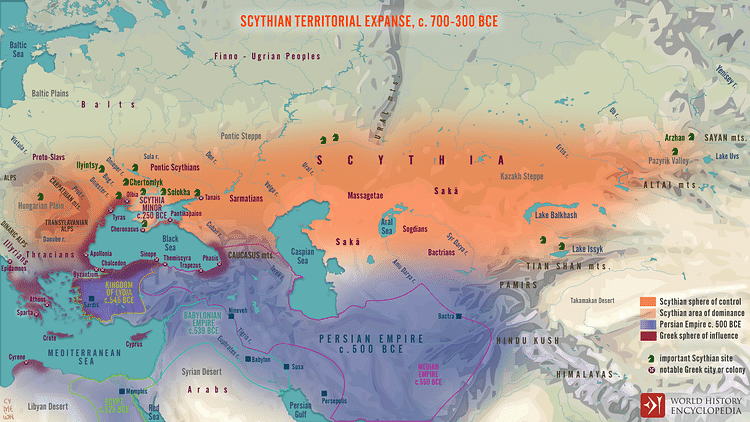
While the lion's share of inquiry into shamanism focuses on the ecstatic element, medicinal prescription – as evidenced especially by the Scythian shamans – would not only have been supplemental but essential. One instance of Scythian expertise in the use of plants was their utilization of cannabis to alleviate pain. In 1993, in the easternmost reaches of the Scythian confederation at Ak-Alakha on the Ukok Plateau in the Altai Mountains, excavators found the burial site of the 'Siberian Princess' who may have been a shaman or healer. Having died young in her 20s, it is now believed she suffered and expired from cancer. With a pouch of cannabis found at her side, the pain-relieving effects of cannabis may have given her a degree of relief.
The medicinal acumen of the Scythian shamans is revealed when Mithridates VI (r. 120-63 BCE) hired them to be part of his retinue. Ruler of the Hellenistic kingdom of Pontus in northern Anatolia, Mithridates was Rome's most dangerous nemesis. Also known as the 'poison king' because he ingested low levels of his own poison formula as an antidote to assassination, Mithridates was the first westerner to extensively develop such theriac recipes later called mithridatium. Ultimately though, it was a team of Scythian shaman-doctors who apparently were the most expert. Appian of Alexandria shares that after being gravely wounded in the Third Mithridatic War at the Battle of Zela in 67 BCE, by a dart below his eye, and in the knee by a stone:
Mithridates was cured by the Agari who make use of the poison of serpents as remedies. Some of this tribe always accompanied the king as physicians. (Mithridatic Wars, 13.88)
At the time the Agari were at his court, Mithridates was performing extensive toxicology research, impressive enough that Pompey (106-48 BCE) sent his notes to Rome to be translated into Latin. That he trusted the Scythians to heal him certainly reflects the shamans' level of competence in pharmacology. Besides the use of snake poison, the psychotropic and healing properties of plants had already had a long history in the Far East, Asia, and the Mediterranean. Scythian knowledge of plants and their effects is indicated when Herodotus speaks of their use of cannabis for exhilaration. As part of their celebration after the burial of a principal elite, the Scythians would erect a portable sauna shaped like a teepee; red hot rocks were placed in a pit in the middle of the teepee. After anointing their bodies with an ointment made from pounded cypress, cedar, and frankincense wood, they would enter the sauna and throw hemp onto the red-hot rocks and "howl in their joy at the vapor-bath." (4.73-75) Construing shamanic elements to this ritual Eliade says of the Scythians, "One fact, at least is certain: shamanism and ecstatic intoxication produced by hemp smoke were known to the Scythians" (394-96).
Finally, as Herodotus says it was the Enaree's main talent, another tool in the shaman's toolbox was divination. Reminiscent of the common shamanic practice employing rhythmic techniques to induce altered states of mind whereby otherworldly connections are made, certain Scythian diviners, unnamed by Herodotus, would take a bundle of sticks, and as they laid down the sticks one by one, they would prophesy. After gathering up the bundle, they would do it again.
Conclusion
One way to characterize Scythian religion is an amalgamation of beliefs. While in contact with cultures having more anthropomorphized systems, they held on to nature-type worship centered on a residual of the mother-earth goddess in the form of Argimpassa. Hence, while their kurgan finds reveal identity with their animal world and a fertility goddess that held a primary place of importance, they also inculcated anthropomorphized notions of the life visuals with which they were familiar. For example, their gods of the sky, sun, fire, war, and horse were, according to Herodotus, Scythia's equivalence of the Greek gods Zeus, Apollo, Hestia, Ares, and Poseidon.
